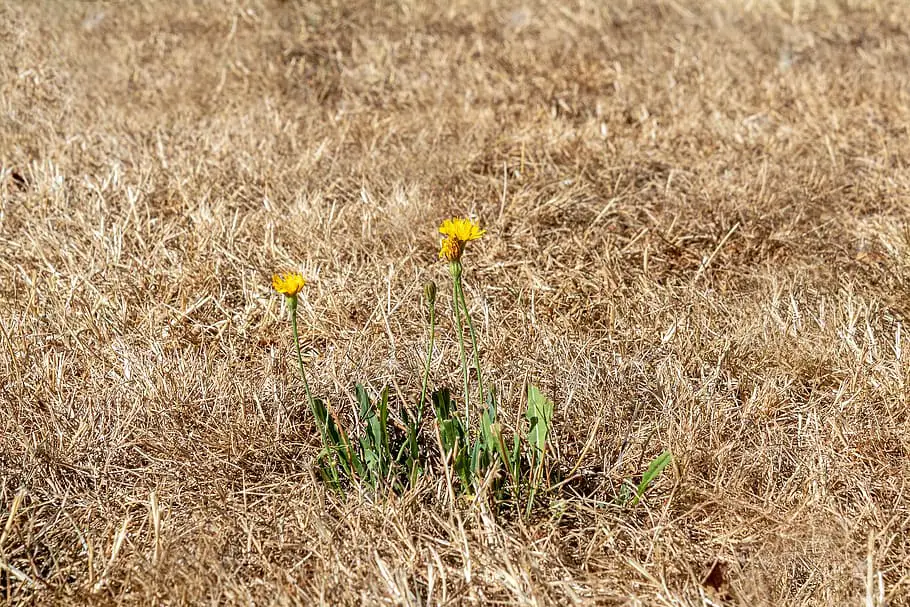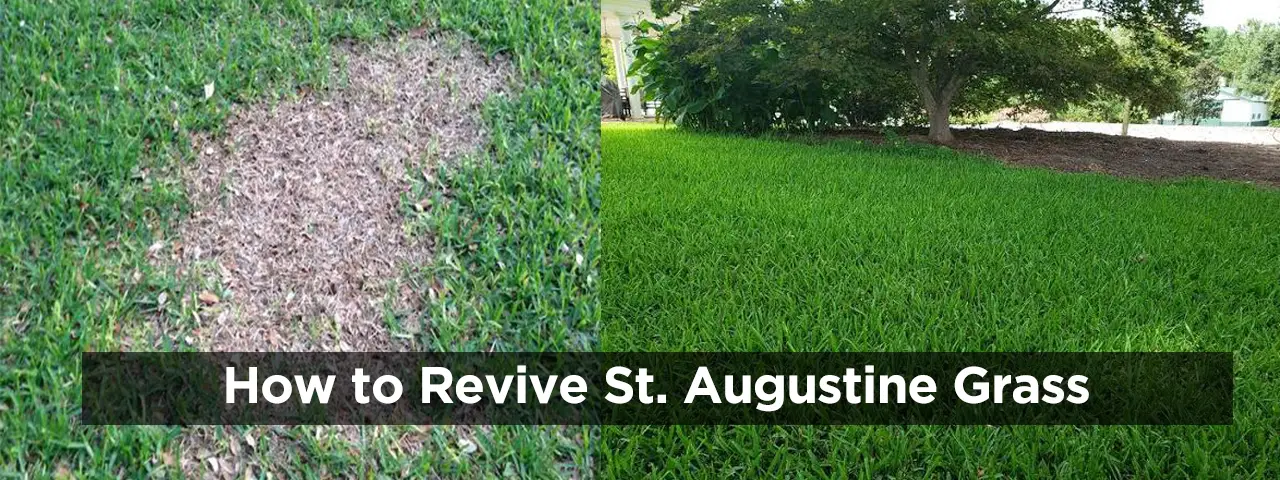How often do you look at your once beautiful and lush St. Augustine grass and think “what did I do wrong”? You are not the only one. A lot of homeowners are in constant search for ideas on how to revive St Augustine grass.
Generally, St. Augustine grass thrives in warm-season and temperate climates. It is drought-tolerant and grows in different soil types. However, cold temperatures, insufficient light, high foot traffic may cause your St. Augustine grass to lose its deep-green color.
If your lawn is filled with dead St. Augustine grass, there are ways to revive it. The best way to revive your St Augustine grass is to water it about three times weekly. Watering the grass deeply will quickly hydrate it and begin the greening process… But before we delve into the process, let’s discuss why St. Augustine grass dies so often.
Why Did My St. Augustine Grass Die?
St. Augustine grasses are high-maintenance plants that require care and maintenance. These grasses are not only susceptible to numerous diseases, but they also have strict watering needs. Nevertheless, St. Augustine grasses remain the ideal warm-season turf grass for home lawns.
As stated earlier, St Augustine grass grows best in warmer climates and well-drained soils. It also requires a lot of gentle care to keep it green. Without adequate attention, they will develop brown spots all over your lawn – an indication that the grasses are dead.
Let’s take a look at more specific reasons why St. Augustine grasses die below.
1. Poor Soil Quality

Whenever you observe brown-dead turfgrasses, the first suspect should be the soil. The significance of healthy soil cannot be overstated, especially for St. Augustine grasses.
Ordinarily, turfgrasses don’t survive in a soil that features rocks and gravels. What’s worse is when the subsoil is a clump of hardened clay.
And here’s why…
St. Augustine grasses favor certain kinds of soil: well-drained, sandy loam soils. Otherwise, its root won’t grow amply to draw nutrients and water from the soil. As a result, the St. Augustine grass will stop growing and wilt until it dies.
We have also seen cases where homeowners use a well-drained sandy loam soil but still observe brown spots in their St. Augustine grass.
If that’s what you’re facing, do a soil nutrient analysis on your lawn area. This analysis or test will determine the nutrient levels within the soil and suggest solutions on how to revive your St Augustine grass
2. Drought Stress

St Augustine thrives well under moist conditions and has little tolerance for drought. Perhaps wetting won’t be much of an issue during fall and winter because you can depend on rain. In the summer, however, your lawn will develop dry patches if you don’t water it adequately.
That begs the question, how often should you water your St. Augustine grass?
In this case, there is no universal frequency – and for good reasons. It is best to adjust the watering according to your observations rather than having a preset number of times to water your turfgrasses.
Nonetheless, the ideal watering requirement for St. Augustine grasses in a sandy loam soil is ¾ inch of water twice a week. You can also wet your lawn once a week, depending on your observation. Also, be wary of waterlogged soils: it attracts diseases.
In all, you shouldn’t leave your St. Augustine grass for six weeks without watering it. If you do, the grass will turn brown and eventually die.
3. Excessive Use of Fertilizer

After the drought stress in the summer, many homeowners embark on rigorous lawn maintenance projects in the spring. Frankly, such projects are good. However, most homeowners fail to appropriate the use of fertilizer.
As much as you want your lawn to look lush and attractive, it is best if you do not apply fertilizer excessively. If the fertilizer is organic, that’s fine! Excessive use of inorganic fertilizers, on the other hand, can damage your St. Augustine grass.
For instance, applying nitrogen fertilizer excessively can damage your lawn. This means an excess of nitrogen can cause a diminished root system as a result of over-applying fertilizer.
What’s more, watch your pets. When a dog urinates, protein is released as nitrogen. Yes, nitrogen is useful for your lawn, but a large amount can burn the grass.
So, what’s the correct way to fertilize your lawn?
It would be best if you fertilized your St. Augustine lawn three times during growing seasons. Here’s how and when to apply fertilizer:
- First in Early may
- Second in June or July
- Third in mid-August
Most importantly, carry out a soil test to determine how much fertilizer to apply. Also, apply the fertilizers according to the instructions written on the product.
4. Lawn Diseases

Diseases such as brown patches and gray leaf spots are quite common. Brown patch disease is a fungal disease that is common during the fall and spring when there is high precipitation and humidity.
Another contributing factor to brown patch diseases is the excessive use of fertilizer. The components of fertilizers are natural food to fungus. That is why brown patch diseases attack over-fertilized lawns.
Lastly, soil compaction similarly increases the chances of brown patch disease on your turfgrasses. When the subsoil compacts, your soil starts losing essential properties like porosity and permeability. With those properties gone, your yard loses its ability to drain water.
So, what are the signs of brown patch disease?
- The occurrence of brown spot on the lawn
- Brown stolons and crowns of the St. Augustine grass
- Random discoloration of the St. Augustine’s grass blade
Gray leaf spot, on the other hand, occurs during hot and warm temperatures. Unlike brown patch disease, gray leaf spot starts with a purple coloration.
5. Insect Infestation
St. Augustine grasses naturally attract insects such as grub worms and chinch bugs. Chinch bugs notably are deadly – it poses more danger to your lawn than grub worms. And that is because it (chinch bug) feeds on your grass through all the development stages (from nymph to adult).
What Chinch bugs do is sip the sap of your St. Augustine grasses from the base of its leaf. And it can do that continuously between April through October.
If you don’t manage chinch bugs infestation early, your grasses will turn yellow and such discoloration will spread across the lawn. The result is habitually an irregular-shaped area of dead or dying grasses.
Grubs worms are likewise harmful to your grass. Unlike chin bugs that feed on leaves, grub worms feed on the root of St. Augustine grasses. That way, it (grub worm) prevents the grass from drawing ample nutrients and water from the soil.
How To Revive St Augustine Grass
The solution is usually to reduce the volume of the fertilizers you use in the fields. Your last resort should be pesticides. And if you have to use pesticides on your lawn, it is best to use the fertilizers approved by your state government.
Now that you know why your grasses are dying, let’s discuss how to revive St Augustine grass.
Your lawns might be brown, but that doesn’t necessarily mean that the St Augustine grasses are dead – at least, not yet. It might be brown as a result of dormancy.
Besides, you can revive a grass that appears dead within 5 weeks. Nonetheless, it’s best to ascertain if your grasses are dead.
How?
Try to pull some parts of the grass off. If it comes off freely, that means you’ll have to re-sod your lawn. On the other hand, if you find it hard to pull the grasses off the soil, you’re in luck.
Here is what you should do…
1. Water Your Lawn

The first solution to a dying or dead St. Augustine plant is improved watering schedules. As such, you might need to increase your current watering strategy from twice to thrice a week.
That’s not all; you also need to water your lawns deeply. Increase the usual depth from ¾ inches to 1½ inches of water on each of your watering schedules.
Next, continue watering your turf continuously for 3 to 4 weeks. Ordinarily, the turfs will start turning green and thick after such rigorous watering.
However, a turf that is already dead as a result of drought won’t grow irrespective of improved watering.
2. Remove Thatch from Your Lawn
Irrespective of how frequent and deep you water your St. Augustine grass, if it features an accumulation of thatch, it won’t regain its lushness. Moreover, thatch attracts insects to what you are reviving -thatches are natural habitats for chinch bugs and gray spot worms.
Furthermore, thatch competes with reviving St. Augustine grass for nutrients. So, what can you do?
De-thatch your lawns. This will not only release more nutrients, but it will also improve your soil aeration.
3. Check and Improve Your Soil Quality
Even after de-thatching and improved watering, poor soil won’t help your St. Augustine’s revival project. As earlier stated, St. Augustine grasses thrive well in well-drained soils. You should work on yours.
Use these steps to improve your soil if you must revive your grass.
- Ensure there is an ample volume of soil available to support the root development of the St. Augustine grass.
- Examine the nutrient needs of your lawn by carrying out a soil test. Look out for the proportion of organic matter in your soil. If the percentage composition of organic matter for the soil in your lawn area is lesser than 5%, try to improve it.
- Add nutritious topsoil that is rich in humus and compost to your lawn. It will improve the St. Augustine grass chances of survival for your
How to Reseed Your Lawn?
Do not worry if you have to reseed St. Augustine grass. It is a chance for you to make your lawns the envy of the neighborhood.
Since you’re starting anew, ensure that the conditions are perfect – else, the St Augustine grass won’t thrive. What are these conditions?
- Ensure to appropriate a pH range of 5 to 8 for the soil in your lawn area.
- Till the soil, at least 4 inches deep, to loosen up any form of compactness. Doing this will help improve permeability in your lawn.
- Add compost to your lawn, at least an inch deep. Why? Using compost is better than organic fertilizers since it’s natural and sustainable.
- Plant the new seed. Ensure that the seeds touch the soil directly to grow. In other words, remove debris, stones, and weed before planting.
- Cover the seed (now planted) with at least ⅛ inches of soil using a rake. This act would hold the seed in place regardless of birds or winds.
- Water the seed deeply twice within 5-10 minutes daily for ten days. After the seed germinates, you can cut back to 15-30 minutes. It is best to water the seeds in the morning before 10 am.
- As the seed grows, ensure the shading is mild. St. Augustine grasses need at least 5 hours of sunlight per day to grow abundantly.
- Restrict movements on your lawns and make sure your pets don’t pee in your lawn area.
And there you have it! In all, you shouldn’t neglect your St. Augustine grass. Always attend to it and check to see if it’s growing properly. That is the best strategy on how to revive St Augustine grass.
Good luck!
We recommend products from companies like Amazon, which we also get a small commission from, to keep this website running. However, we want to stress that all of the products we recommend are tested, used by us, and 100% unbiased and true.

